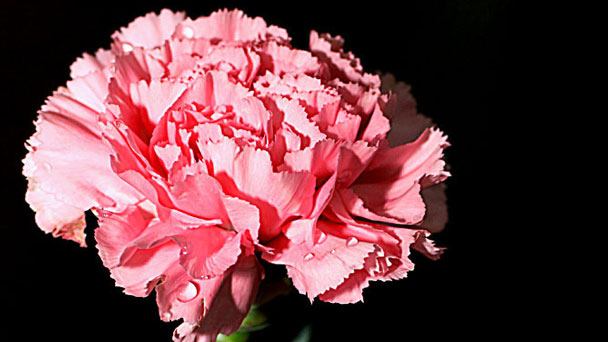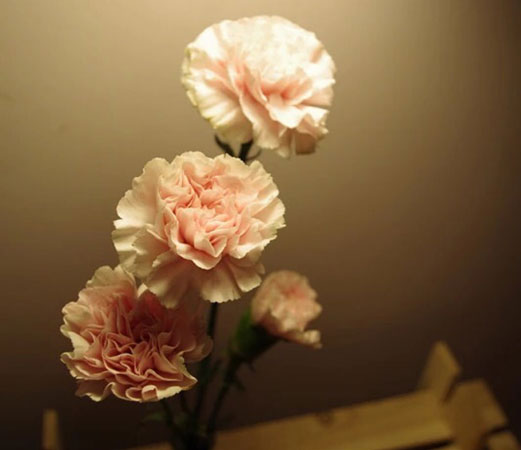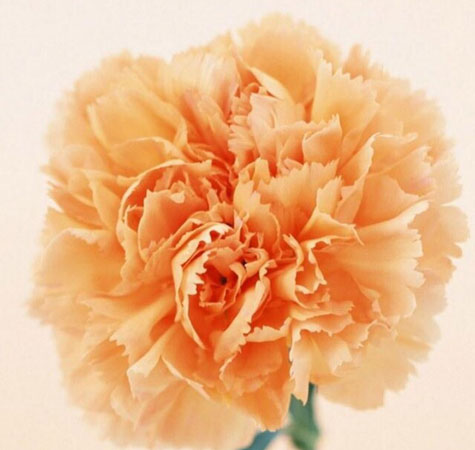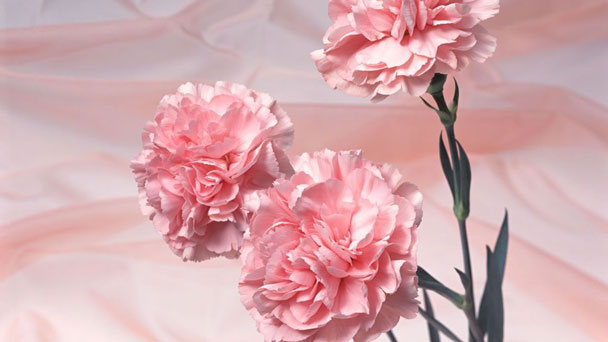Carnation Plant (Dianthus Caryophyllus) Grow & Care Guide
Written by Iris
Nov 13 2021

The carnation (Dianthus caryophyllus) is a perennial herb. Carnation is part of the Caryophyllaceae family and is native to southern Europe and India. Carnation flowers are evergreen plants with a tufted habit of gray-green leaves. They bloom from spring to summer. The flowers are loosely clustered in red, pink, purplish red, yellow or white, and are fragrant. Carnations prefer sunny spots in gardens with well-drained soil. In warm climates, protect them from the hot afternoon sun.
To plant Carnation from seed, begin indoors 2-8 weeks prior to the last frost for your area. Plant in a light, loamy soil mix, sprinkling seeds over the top, and then covering with a light layer of soil.
Cover the container with a cloche or plastic bag to keep the soil moist and warm. Once seedlings have 2-3 true leaves, move into their own pots. Transplant outdoors once they’re 4-5 inches high.
To direct sow outdoors, plant seeds to a depth of 1/8 inch once all danger of frost has passed. Keep the soil moist, and once they have 2-3 leaves, thin to 8-12 inches apart.
Trim away the lower leaves, leaving 4-5 sets of leaves at the top of the stem. Dip the base into hormone rooting powder, and pot up around the perimeter of a container filled with a light potting soil.
Water, then place in a plastic bag, securing the top with a twist tie. Set in a sheltered spot in the garden that receives morning sunlight, but out of hot afternoon sun.
Stem cuttings should root in about 4-5 weeks. Remove the soil ball and gently separate the cuttings, then pot up into individual containers.
Overwinter in a sheltered spot that is protected from frost and freezing temperatures. Plant Carnation out in spring once the soil warms up.
It's necessary to keep the soil humid during the first two or three weeks in order to improve the Carnation roots'growth. The ideal time for division is before a new budding.
Different plants have different water needs. Some plants prefer staying on the dry side, others like to be consistently moist. Refer to the Carnationplant label to check a plant’s specific requirements.
Ideally water should only be applied to the root zone - an area roughly 6-12” (15-30cm) from the base of the plant, not the entire plant. A soaker hose is a great investment for keeping plants healthy and reducing water lost through evaporation. Hand watering using a watering wand with a sprinkler head attached is also a good way to control watering. If the garden area is large, and a sprinkler is necessary, try to water in the morning so that plant foliage has time to dry through the day. Moist foliage encourages disease and mold that can weaken or damage Carnation plants.
To check for soil moisture use your finger or a small trowel to dig in and examine the soil. If the first 2-4” (5-10cm) of soil is dry, it is time to water.
Too much fertilizer can actually damage plants so it’s important to follow the package directions to determine how much, and how often, to feed plants. (Find more fall flowers here.)
Remove old flowers to keep plant looking healthy and prevent seed production that drains the plant’s energy at the expense of forming new flowers.
Some plants are grown only for their attractive foliage (such as coleus, dusty miller and flowering kale). Their flowers are not very showy and any buds should be pinched off to keep the foliage looking its best. (Find more fall plants here.)
Keeping a carnation at a dark location, which contains too much humidity, might lead to fungal diseases. If this is the case, the plant needs to be implanted into fresh soil mixed with nutrient-rich substrate and situated at a bright place. Normally, carnations recover quickly.
Greenflies are one of carnations’ biggest enemies. They feed from the leaves and cause them to wither. There will be no blossom. Insecticide, which is available in garden shops, helps. Organic insecticide against greenflies poses an eco-friendly alternative to chemical products.
Especially young plants are frequently plagued by snails. They devour the leaves almost completely. Apart from the visual damage, there will also be disturbances in growth and absences of budding. In spring, you should distribute snail bait around your carnations preventively.
The perennial varieties include Cheddar (Dianthus gratianopolitanus), Cottage (Dianthus plumarius) and Grass pinks (Dianthus armeria). The foliage on all of these is blue-gray and each comes in a rainbow of colors.
D. barbatus is the common Sweet William and a biennial. There are both double and single flowers and the variety reseeds itself.
E. Allwood pinks (Dianthus x allwoodii) are long lasting with flowering extending at least 8 weeks. They are mostly double flowering and come in two sizes, 3 to 6 inches (8-15 cm.) and 10 to 18 inches (25-46 cm.) tall.
Read Next:
Top 30 Fall Flowers to Plant Beautiful Autumn Flowers
30 Fall Plants for a Beautiful Fall Garden
How to Grow Carnation PlantGrow Carnations from SeedsGrow Carnations from Stem CuttingsGrow Carnations from DivisionHow to Care for Carnation PlantCarnation Light RequirementsCarnation Soil CareCarnation WateringCarnation Temperature & Humidity CareCarnation FertilizerCarnation PruningCarnation Pests & Diseases CareVarieties of CarnationCarnation Plant Care FAQWhat does a carnation symbolize?Are carnations safe to eat?
How to Grow Carnation Plant
Grow Carnations from Seeds
Carnation plant can be propagated from seeds started indoors, directly sown into the garden, or grown from stem cuttings.To plant Carnation from seed, begin indoors 2-8 weeks prior to the last frost for your area. Plant in a light, loamy soil mix, sprinkling seeds over the top, and then covering with a light layer of soil.
Cover the container with a cloche or plastic bag to keep the soil moist and warm. Once seedlings have 2-3 true leaves, move into their own pots. Transplant outdoors once they’re 4-5 inches high.
To direct sow outdoors, plant seeds to a depth of 1/8 inch once all danger of frost has passed. Keep the soil moist, and once they have 2-3 leaves, thin to 8-12 inches apart.
Grow Carnations from Stem Cuttings
To grow Carnation from stem cuttings, cut away several non-flowering stems from the parent plant just below a leaf joint.Trim away the lower leaves, leaving 4-5 sets of leaves at the top of the stem. Dip the base into hormone rooting powder, and pot up around the perimeter of a container filled with a light potting soil.
Water, then place in a plastic bag, securing the top with a twist tie. Set in a sheltered spot in the garden that receives morning sunlight, but out of hot afternoon sun.
Stem cuttings should root in about 4-5 weeks. Remove the soil ball and gently separate the cuttings, then pot up into individual containers.
Overwinter in a sheltered spot that is protected from frost and freezing temperatures. Plant Carnation out in spring once the soil warms up.
Grow Carnations from Division
Division is the ideal way of propagation when a mother plant needs to be diminished. The mother Carnation plants needs to be dug out and cut to pieces with a sharp knife or spade. You need to make sure that all parts have buds. Following this, all parts need to be planted in the previously mentioned fashion. It's recommendable to enrich the soil with compost.It's necessary to keep the soil humid during the first two or three weeks in order to improve the Carnation roots'growth. The ideal time for division is before a new budding.

How to Care for Carnation Plant
Carnation Light Requirements
Although they do best in full sun, carnations are fine with some partial shade. Too much bright afternoon sun might cause the petals of brightly colored carnations to fade. Plant your carnations where they'll get morning sun rather than afternoon sun, if possible, to keep the flowers looking fresh and the colors bright.Carnation Soil Care
Carnation plants grow well in most soil types, but they need soil that is well draining. To get the best blooms a soil that is moist, humus-rich and slightly alkaline is best. Enrich the soil with compost or manure and a handful of blood and bone or complete fertiliser. Avoid heavy soils and water logging, especially in Winter.Carnation Watering
New Carnation plantings should be watered daily for a couple of weeks. After that, depending on the weather and soil type, watering can be adjusted to every two or three days. Clay soils hold moisture longer than sandy soils, so expect to water more frequently in sandy settings.Different plants have different water needs. Some plants prefer staying on the dry side, others like to be consistently moist. Refer to the Carnationplant label to check a plant’s specific requirements.
Ideally water should only be applied to the root zone - an area roughly 6-12” (15-30cm) from the base of the plant, not the entire plant. A soaker hose is a great investment for keeping plants healthy and reducing water lost through evaporation. Hand watering using a watering wand with a sprinkler head attached is also a good way to control watering. If the garden area is large, and a sprinkler is necessary, try to water in the morning so that plant foliage has time to dry through the day. Moist foliage encourages disease and mold that can weaken or damage Carnation plants.
To check for soil moisture use your finger or a small trowel to dig in and examine the soil. If the first 2-4” (5-10cm) of soil is dry, it is time to water.
Carnation Temperature & Humidity Care
Carnations like a warm environment, but will wilt in extreme heat. They do best in low humidity. However, an occasional light spritz of cool water during very hot weather may help cool them down a bit.Carnation Fertilizer
Fertilizers are available in many forms: granulated, slow-release, liquid feeds, organic or synthetic. Determine which application method is best for the situation and select a product with a nutritional balance designed to encourage Carnation blooming (such as 5-10-5).Too much fertilizer can actually damage plants so it’s important to follow the package directions to determine how much, and how often, to feed plants. (Find more fall flowers here.)
Carnation Pruning
Prune carnation plants freely to maintain the desired size and shape. Pinching Carnation plants back stimulates dense, bushy new growth and encourages more flowers.Remove old flowers to keep plant looking healthy and prevent seed production that drains the plant’s energy at the expense of forming new flowers.
Some plants are grown only for their attractive foliage (such as coleus, dusty miller and flowering kale). Their flowers are not very showy and any buds should be pinched off to keep the foliage looking its best. (Find more fall plants here.)
Carnation Pests & Diseases Care
Carnations are not prone to special diseases. However, the risk for illnesses is higher when they are not treated properly.Keeping a carnation at a dark location, which contains too much humidity, might lead to fungal diseases. If this is the case, the plant needs to be implanted into fresh soil mixed with nutrient-rich substrate and situated at a bright place. Normally, carnations recover quickly.
Greenflies are one of carnations’ biggest enemies. They feed from the leaves and cause them to wither. There will be no blossom. Insecticide, which is available in garden shops, helps. Organic insecticide against greenflies poses an eco-friendly alternative to chemical products.
Especially young plants are frequently plagued by snails. They devour the leaves almost completely. Apart from the visual damage, there will also be disturbances in growth and absences of budding. In spring, you should distribute snail bait around your carnations preventively.

Varieties of Carnation
There is a dianthus plant for almost any garden space and region. The typical annual dianthus is the Dianthus chinensis, or Chinese pinks.The perennial varieties include Cheddar (Dianthus gratianopolitanus), Cottage (Dianthus plumarius) and Grass pinks (Dianthus armeria). The foliage on all of these is blue-gray and each comes in a rainbow of colors.
D. barbatus is the common Sweet William and a biennial. There are both double and single flowers and the variety reseeds itself.
E. Allwood pinks (Dianthus x allwoodii) are long lasting with flowering extending at least 8 weeks. They are mostly double flowering and come in two sizes, 3 to 6 inches (8-15 cm.) and 10 to 18 inches (25-46 cm.) tall.

Carnation Plant Care FAQ
What does a carnation symbolize?
The carnation means fascination, distinction, and love. According to a Christian legend, carnations grew from the Virgin Mary's tears as she watched Jesus carry the cross. This is how they became associated with motherly love.Are carnations safe to eat?
Only the petals are edible. Carnations (Dianthus caryophyllus) can be steeped in wine, candy, or use as cake decoration. To use the surprisingly sweet petals in desserts, cut them away from the bitter white base of the flower. Petals add color to salads or aspics.Read Next:
Top 30 Fall Flowers to Plant Beautiful Autumn Flowers
30 Fall Plants for a Beautiful Fall Garden
Latest Updated
- Benefits of Bugleweed - 7 Science-backed Health Benefits
- Bugleweed Dangers & Side Effects - Is It Poisonous?
- How to Plant Evergreen Trees - What You Should Know
- When to Plant Evergreens - Grow Guide for Evergreen Trees
- 12 Wonderful Evergreen Shrubs for Your Garden
- 12 Popular Evergreen Plants with Pictures for Beginners
- When And How To Prune A Lilac Bush Like a Pro
- How to Grow & Care for Lilac Vine (Hardenbergia Violacea)
- Japanese Lilac Tree (Syringa Reticulata) Care & Propagation Guide
- Shumard Oak Pros and Cons - What to Know
Popular Articles
- Winter maintenance of Antirrhinum Majus
- How to Grow Terminalia Mantaly Tree
- How to Grow and Care for Crossostephium Chinense
- How to grow Antirrhinum Majus in spring
- Peristeria Elata (Dove Orchid) Profile: Info & Care Guide
- Underwatered Snake Plant (Sansevieria Trifasciata) - Signs And How To Fix
- How to Care for Brazilian Jasmine Plant (Mandevilla Sanderi)
- How to Grow & Care for Graptopetalum Purple Delight in Summer
- Rosa Chinensis (China Rose): Plant Growing & Care Tips
- How to Care for Baby Sun Rose (Aptenia Cordifolia)